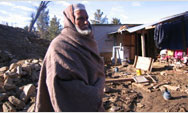You are here » Home » Telling Our Story
First Person
The clearing of 111 km of canals provided jobs for over 4,300 local farmers
Rehabilitation of Irrigation Systems in Afghanistan

Photo: RAMP, AfghanistanSusan DeCamp
Local farmers from Kunduz working to de-silt the Char Dara irrigation system in Northeast Afghanistan.
“For the first time in twenty-five years, we’ll have the water necessary to improve our crops. With the wages farmers are earning [by working on the canals], we can buy bicycles, pay off our debts and provide better lives for our families.”
- Local farmer Mirab Gul Hassan
Major irrigation rehabilitation projects in Baghlan and Kunduz, Afghanistan have contributed to communities that are excited about their prospects for the future. USAID rehabilitated three major rural irrigation systems and returned more than 300,000 hectares of cultivated land to full irrigated production. This included de-silting and widening irrigation canals, repairing and replacing water intakes, canal banks, protection walls, turnouts, and sluice gates. In general, the completed projects are providing a reliable source of water for irrigation which has the potential to double the regions’ crop yields.
The Char Dara, Bala Doori and Darqad irrigation projects were all completed in March and April of 2004, in time for the spring planting season. The rehabilitation of these irrigation systems has proven to be a community building endeavor. Hundreds of local farmers were employed on the project sites. The local Irrigation Departments and Mirabs (water committees) were involved in each step of the planning and implementation process. As a result, the community members learn what is necessary to maintain their irrigation systems, the employment opportunities inject cash into the local economies, and farmers get the water they need to improve their crop yields and income.
Print-friendly version of this page (244kb - PDF)
Back to Top ^
|




